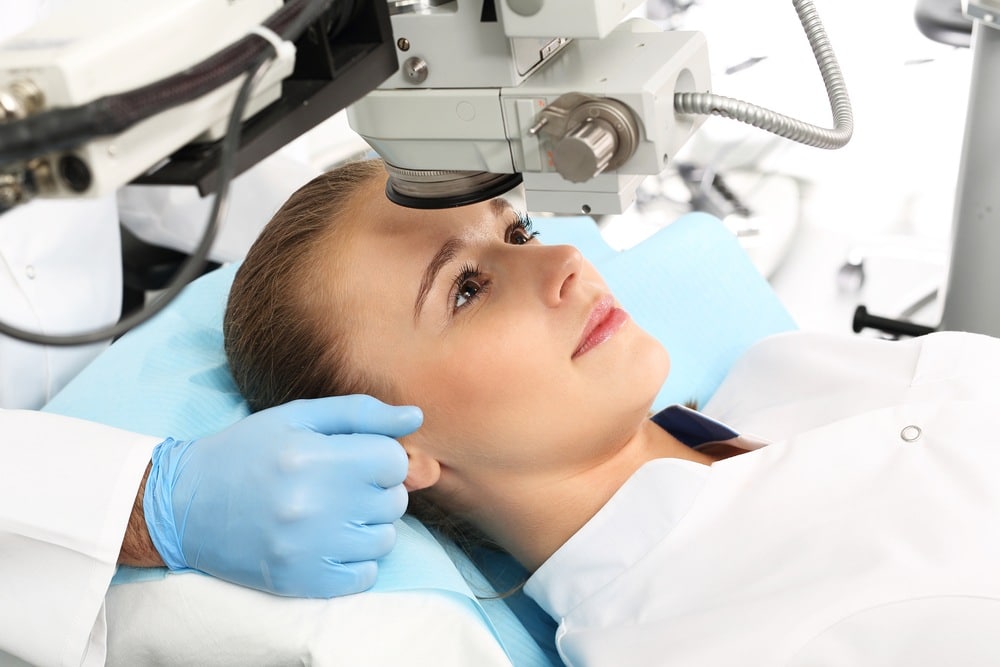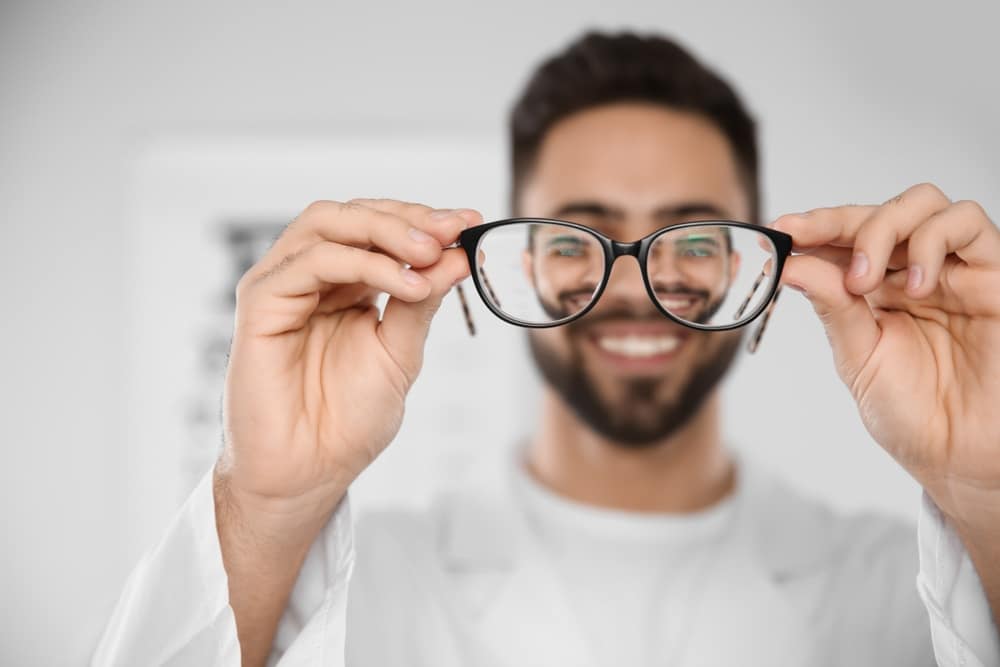Do you have trouble seeing the board in class? Maybe you notice that street signs aren’t quite as clear while you’re driving. It’s possible that you have myopia, and you aren’t alone.
Approximately 30% of Americans have myopia, or nearsightedness. The condition can become severe as patients approach their teenage years and affects 40% of children by the time they are seventeen years old.
Let’s talk about nearsightedness, myopia symptoms, and treatment options.
What Is Nearsightedness (Myopia)?
Myopia is a refractive eye problem that occurs in children and adults. This common eye problem often arises when patients are in their childhood and progresses into adulthood. You have a chance of needing myopia treatment if both of your parents have it because their genetics can influence the occurrence of the condition.
What Causes Myopia?
The primary cause of myopia is refractive error. This error occurs when your eyes cannot focus light properly, causing you to have blurry vision. It implies that your eyes focus light in front of the retina, but they should focus light on the retina.
The retina is a layer of tissue near the optic nerve that collects light and converts it into multiple electrical impulses the brain registers as images. If the light is focused in front of the retina, it leads to interrupted electrical impulses, causing blurriness.
In some situations, those who have myopia may have an abnormal eye shape. This is because the eyeball is very long, or the cornea is rounded. These abnormalities make it hard for myopia patients to see clearly. Other causes of myopia include:
- Age: Myopia can begin in childhood, but often begins during one’s teenage years and progresses as we age. You may also experience other eye problems as you become older.
- Family genetics: You may inherit myopia, especially if both of your parents suffer from the condition. You may also get the condition if one of your parents has myopia, but the probability may not be high.
- Visual stress: Sometimes, myopia can be an environmentally acquired condition. For instance, if you are constantly using your computer at work, it may cause temporary myopia. If your children spend a lot of time on screens, they may get temporary myopia, which may progress as they age.
Myopia Symptoms
The main myopia symptom is blurry vision, especially when looking at distant objects. For example, there may be a high probability you have nearsightedness if you cannot see various road signs when driving. You may have myopia if your child cannot see the whiteboard clearly in school or see things on the television. Other myopia symptoms include:
- Having eye strain issues, especially when you are tired or your eyes are hurting
- Squinting your eyes when looking at far objects
- Frequent headaches
You may not notice any myopia symptoms if your condition is mild. Others may even assume that their myopic vision is normal. These symptoms can easily be corrected by wearing contact lenses or eyeglasses. However, you may experience headaches because your eyes must adjust to the glasses.
It’s a good idea to go for a thorough check-up to ascertain this condition because other conditions can cause blurred vision. For example, if you have glaucoma or a detached retina, it may cause the same effect.
How Myopia Is Diagnosed
The doctor may diagnose you with myopia when conducting various eye examinations. Most examinations are designed to determine your eye health and vision quality. You must go for regular eye check-ups to allow the doctor to monitor your eyes and prescription if you have been diagnosed with an eye problem. Your age and medical history should determine how often you should have your eyes checked.
An eye examination consists of the following tests, which may indicate whether you have myopia or not. They include:
- Visual activity tests: The physician may ask you to read various letters and symbols spaced differently on the chart. It aids them in knowing if you have a problem reading letters that are far away.
- Your medical history: The doctor will check your medical history to determine if you have been diagnosed with an eye condition in the past. They will also evaluate the medications you have been taking to determine if they have affected your vision. Your medical history will depict your family’s history with myopia to determine if this is the leading cause.
- Refraction tests: The eye doctor uses specific equipment to check people’s eyes and determine if they have a refraction error. These results will determine if you have myopia.
- Pupil examination: The doctor will test your pupils to ensure they respond appropriately. They will shine a bright light into your eyes to see if the pupils will shrink. If they react differently, your eyes may have a problem.
- Retina and optic nerve examination: The doctor may use dilating eye drops during this examination to widen the pupils and check the retina and optic nerve. The test will then reveal if these parts of the eyes are damaged.
- Eye movement tests: These are tests that determine your eye movement and are conducted to evaluate your eye muscles.
Myopia Treatment

Nearsightedness treatment involves surgery, wearing glasses for myopia, cornea reshaping therapy, vision therapy, and using eye drops. Let’s discuss these myopia treatment procedures in detail.
Wearing Glasses for Myopia
Glasses for myopia provide an effective solution to this condition. The optician will prescribe the glasses since they must determine how strong the lenses should be to ensure you have clear vision.
These glasses are concave-shaped and will help the eyes reflect light on the right part of the retina. You can select glasses based on your preference. For instance, you may get glasses ideal for driving, especially if you cannot see cars and road signs very far away.
Wearing glasses for myopia may reduce eye strain and headaches, especially after your eyes get used to them. When selecting the right glasses, you can choose any frame you want, which can be customized to meet your style. An experienced optician can help you choose the best frame for your prescription. Make sure that you take care of your prescription glasses to ensure they last a long time.
Surgery
In other circumstances, the doctor may consider surgery as a possible treatment for myopia. It entails laser eye surgery that aids in reshaping your cornea to ensure light is accurately focused on the retina.
The doctor must numb your eyes with eye drops to ensure they operate on the right eyes. You will be awake during the surgery but sedated to ensure the procedure is painless.
Be aware that you may experience some side effects as your eyes recover. These include an itching and burning sensation. Ultimately, you may no longer need myopia glasses or contact lenses after surgery. This myopia treatment is mainly suitable for adults.
Cornea Reshaping Therapy
Cornea reshaping therapy entails using specific lenses to change the shape of your cornea. This is an excellent treatment to flatten the cornea. It uses reverse geometry and gas-permeable lenses to flatten the cornea and steepen it to provide foveal vision. It changes the way light focuses on the eyes, ultimately slowing the progression of myopia.
Unlike other contact lenses, these cornea reshaping lenses are worn at night and are non-invasive. You will see some changes after a week and this is a safe treatment option for children and adults.
Using Eye Drops
The doctor may recommend low doses of atropine, which will slow myopia progression. This treatment is mainly suitable for children since surgery is not suitable for them. Eye drops are very effective because asking your child to always wear their myopia glasses may be difficult, especially when playing.
Vision Therapy
Some children develop myopia because they have weak visual skills. Visual therapy aids in improving a child’s optical system, which enhances the eye-brain connection. Ultimately, it helps children focus more effectively, especially when reading.
Clearing Things Up

Myopia occurs when you cannot see far away objects, but you can see the close ones. If this condition is left untreated, it may become severe as you age. A refractive error causes nearsightedness, especially in people with long eyeballs. This condition can be treated with surgery or wearing glasses for myopia. If you or a loved one are suffering from myopia, contact the talented care team at Art of Optiks today to schedule your comprehensive eye exam.

